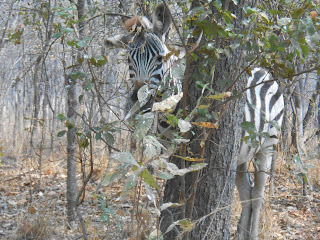 I
find it ironic that for a few moments it almost lines up with America’s fall. When the
msasa trees of southern Africa bloom with a bang into an array of purple to red to
brown, one knows the season. But here it’s not fall, it’s spring!
I
find it ironic that for a few moments it almost lines up with America’s fall. When the
msasa trees of southern Africa bloom with a bang into an array of purple to red to
brown, one knows the season. But here it’s not fall, it’s spring!
Msasa
(mah-sah-sah) trees dot the tropical woodland landscape of Zim, where
locals have a great pride for the native species. The msasa is most famous for
bearing marks of the seasons right on schedule throughout the year. The famous tree loses its leaves as the cool
season begins gradually in May. In August, the trees are entirely bare, echoing
the barren cold weather that is almost at an end. By late August, as spring blows in, the
colorful leaves begin to pop out. Here
the color indicates growing life, rather than the deadening of American leaves that
fall in a colorful menagerie. After
20-25 days, the msasa leaves shift to a dark green color before the tree’s
tiny, pungent, green flowers appear. In
April, the 4-6 inch seed pods that hang from the Msasa branches pop open
explosively, launching flat seeds in all directions.
The top two pictures are too beautiful to be taken by me! Below are some pictures of our recent visit to the Lake Chivero area. The severe dryness of the landscape allows the prominent colors of the msasas to take center stage.


As
a medium sized tree found only in south-eastern Africa, the msasa grows best in
tropical woodlands in which there is a stark difference between the wet and dry
season. The tree is known for growing very slowly and therefore is rarely found
outside of natural occurrence. The bark of the msasa is useful, as it contains tannin, used for tanning animal hides. The tree, however, provides an inferior timber. It is
considered heavy and too frail to be useful for most wood furniture or
building, and is instead most often used for firewood. I find the tree most useful to the eyes. Welcome, spring in southern Africa!



